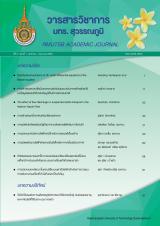อิทธิพลของสนามแม่เหล็กภายนอกต่อสมบัติแนวเชื่อมพอกผิวแข็งของเหล็กกล้าคาร์บอนต่าด้วยกระบวนการเชื่อมแก๊สทังสเตนอาร์ค
Main Article Content
Abstract
การเชื่อมพอกผิวแข็งเป็นหนึ่งในกระบวนการที่นิยมใช้มากที่สุดในการปรับปรุงชิ้นส่วนที่มีการสึกหรอ เช่น ชิ้นส่วนด้านการเกษตรกรรม ชิ้นส่วนในโรงงานน้ำตาล หรือชิ้นงานที่มีการเสียดสีของวัสดุ วัตถุประสงค์ของงานวิจัยเพื่อศึกษาอิทธิพลของสนามแม่เหล็กภายนอกต่อโครงสร้างจุลภาค และสมบัติทางกลของแนวเชื่อมพอกผิวแข็ง บนแผ่นเหล็กกล้าคาร์บอนต่ำ AISI 1015 ใช้ลวดเชื่อมพอกผิวแข็งไส้ฟลักซ์ ประยุกต์ใช้กระบวนการเชื่อมแก๊สทังสเตนอาร์คแบบอัตโนมัติ ความเข้มข้นของสนามแม่เหล็กที่ 50-200 เกาส์ ทำการตรวจสอบการสึกหรอของแนวเชื่อมพอกผิวแข็งตามมาตรฐาน ASTM-G65 ศึกษาโครงสร้างจุลภาคและส่วนผสมทางเคมีของแนวเชื่อมพอกผิวแข็งด้วยกล้องจุลทรรศน์อิเล็กตรอนแบบส่องกราด จากการทดลองพบว่า สนามแม่เหล็กจากภายนอกมีผลต่อการกวนของบ่อหลอมละลายในแนวเชื่อมส่งผลต่อจุดบกพร่อง เมื่อเพิ่มความเข้มของสนามแม่เหล็กเพิ่มสูงขึ้นแนวโน้มของจุดบกพร่องในแนวเชื่อมมีค่าลดลง การกระจายตัวของธาตุผสมในแนวเชื่อมดีขึ้นเมื่อเพิ่มความเข้มของสนามแม่เหล็กความแข็งแนวเชื่อมมีค่าสูงขึ้นและอัตราการสึกหรอของแนวเชื่อมลดลง
The influence of external magnetic field on the welded hardfacing properties of the low carbon steel based on gas tungsten arc welding process
The weld hard facing process is one of most commonly used to improve the parts that are worn such as the component of agriculture, sugar mills or the friction material. The research objective was to study the influence of the magnetic field on both microstructure and the mechanical properties of the low carbon steel AISI 1015 welding hard facing. Using flux core wire welding hard facing, the process used by the automatic gas tungsten arc welding (GTAW) the concentration of 50-200 gauss magnetic field. The welding hard facing wear that investigation by ASTM G-65 study the microstructure and the chemical composition of the welding hard facing by scanning electron microscope (SEM) technical. The investigation has shown that the external magnetic affecting the stirring of the weld pool on the affect porosity in the weld. When increasing the intensity of the magnetic field increases trend of defects in the weld decreased, the distribution of alloying elements in the weld was better when the intensity of the magnetic field. The hardness of the welding hard facing was found that the higher and the wear rate of welding hard facing.
Article Details
Published manuscript are the rights of their original owners and RMUTSB Academic Journal. The manuscript content belongs to the authors' idea, it is not the opinion of the journal's committee and not the responsibility of Rajamangala University of Technology Suvarnabhumi


